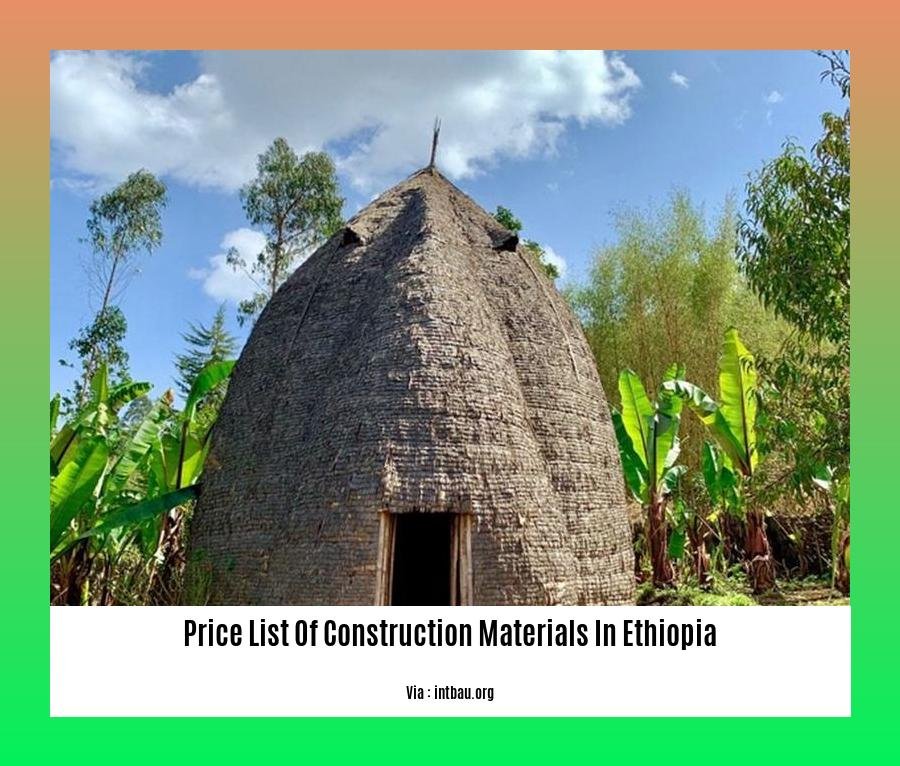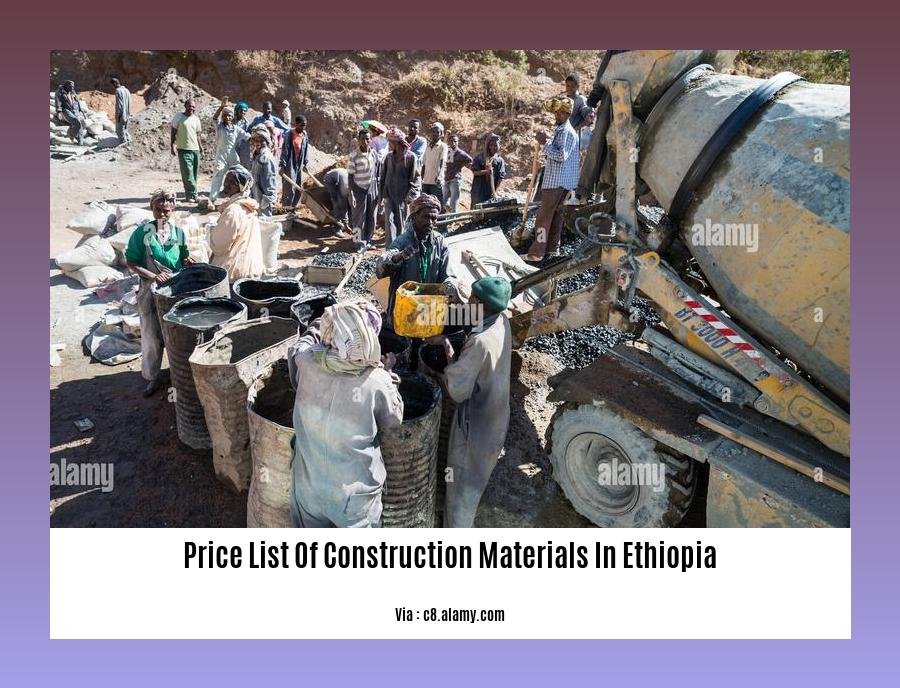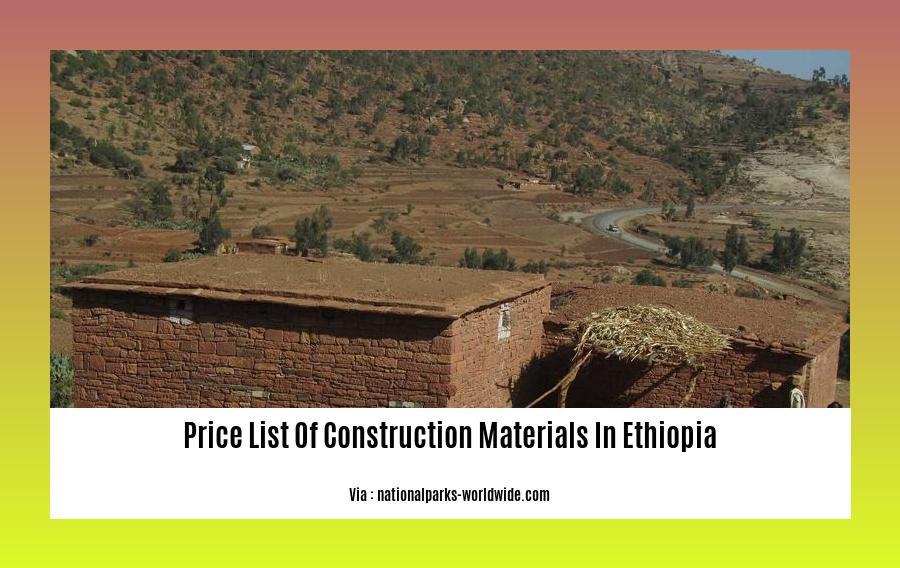Introducing the comprehensive guide: [- Price List of Construction Materials in Ethiopia: A Comprehensive Guide]. Navigate the dynamic Ethiopian construction market with confidence, armed with up-to-date pricing insights and expert guidance. This article delves into the intricacies of material costs, providing a valuable resource for professionals seeking cost-effective solutions and successful project outcomes.
Key Takeaways:
- The construction sector is a significant economic driver for Ethiopia, with a market value of over US$7 billion.
- Ethiopia has standardized programs in the construction industry, with manufacturers offering standardized product ranges.
- Standardized materials include roofing materials, pre-cast concrete, steel windows, doors, and electrical fittings.
- The article provides a table with current construction material prices in Addis Ababa for Reinforcement Bar, Gravel, Sand, and Fino Material.
- Relevant sources for further information include Construction Market Watch and Building Materials in Ethiopia.
Price List of Construction Materials in Ethiopia

Navigating the complexities of Ethiopia’s construction industry requires an up-to-date understanding of the price list of construction materials. Fluctuations in prices, material availability, and regional variations can impact project costs significantly. Here’s a comprehensive overview to help you make informed decisions:
Key Factors Influencing Material Costs
- Market Demand: Construction booms increase demand for materials, leading to price surges.
- Transportation Costs: Distance from production centers to project sites can affect transportation expenses.
- Government Policies: Import tariffs, value-added taxes, and subsidies influence material prices.
- Exchange Rates: Global currency fluctuations impact the cost of imported materials.
Table of Material Prices
To provide a snapshot of current market trends, here’s a table of estimated construction material prices in Addis Ababa:
| Material | Price (ETB) | Unit |
|---|---|---|
| Reinforcement Bar (6mm) | 170 | kg |
| Gravel (02) | 4,000 | m3 |
| Sand | 4,000 | m3 |
| Fino (00) Material | 3,700 | m3 |
Tips for Cost-Effective Procurement
- Negotiate with Suppliers: Engage in direct negotiations with suppliers to secure competitive prices.
- Explore Local Manufacturers: Consider sourcing materials from local manufacturers to reduce transportation costs.
- Compare Prices: Obtain quotes from multiple suppliers before making purchases.
- Monitor Market Trends: Keep abreast of industry news and updates to anticipate price fluctuations.
- Purchase in Bulk: Consider purchasing materials in large quantities to leverage economies of scale.
Conclusion
Understanding the price list of construction materials in Ethiopia is essential for successful project management. By considering the factors influencing costs and implementing cost-effective procurement strategies, you can minimize project expenses and ensure efficient utilization of resources.
You can check our price list for construction materials to make sure you are getting the best rates. If you are planning to do some road construction, make sure to take a look at this article on prime coat.
Market Trends and Supply Chain Dynamics
The construction industry in Ethiopia is experiencing robust growth, driven by increased foreign direct investment and the resumption of halted development projects. This growth has led to increased demand for construction materials, resulting in price fluctuations and supply chain challenges.
Key Takeaways:
- The market is expected to grow at an AAGR of over 8% during 2024-2027.
- Commercial construction is the leading sector, followed by industrial, residential, energy, civil, and infrastructure.
- Webuild SpA is the leading company in the market, followed by China Engineering Group Company Ltd.
Factors Influencing Material Prices:
- Market Demand: Increased demand for construction materials due to the rising number of projects is driving up prices.
- Transportation Costs: The cost of transporting materials from manufacturing sites to construction sites has increased significantly, contributing to higher material prices.
- Government Policies: Government regulations, such as import tariffs and taxes, can impact material costs.
- Exchange Rates: The value of the Ethiopian Birr against foreign currencies affects the cost of imported construction materials.
Supply Chain Dynamics:
- Supply Shortages: Temporary shortages of certain materials, such as steel and cement, can occur due to disruptions in production or transportation.
- Logistics Challenges: Infrastructure limitations and transportation delays can hinder the timely delivery of materials to construction sites.
- Competition: Increased competition among contractors for limited resources can lead to higher material prices.
Impact on Costs:
The combined effect of these factors has led to an overall increase in construction material prices in Ethiopia. Contractors need to be aware of these trends and plan their projects accordingly.
Citation 1
Citation 2
Negotiation Strategies for Cost Optimization in Ethiopian Construction Market

As an experienced construction professional in Ethiopia, I’ve witnessed the significant impact of cost optimization on successful project delivery. Here’s how to leverage negotiation strategies to maximize cost-effectiveness in the Ethiopian construction landscape:
Negotiating with Material Suppliers
- Establish a Baseline: Research market prices through multiple quotes and consider factors like exchange rates, transportation distances, and local availability.
- Leverage Bulk Purchasing: Negotiate discounts on bulk orders for significant cost savings, especially for materials with high volume requirements.
- Explore Local Manufacturers: Connecting with local manufacturers can reduce transportation costs and potentially offer more competitive pricing.
Negotiating Labor Costs
- Hire Skilled Labor: While it may seem counterintuitive, investing in skilled labor can save costs in the long run. They work efficiently, reduce downtime, and minimize rework.
- Negotiate Realistic Rates: Research prevailing wage rates in the area and negotiate within a fair range. Consider factors such as experience, union affiliations, and project complexity.
- Explore Incentives: Beyond monetary compensation, offer incentives like skill development opportunities or flexible work arrangements to attract and retain skilled workers.
Contract Negotiation Tactics
- Include Clear Scope and Specifications: Minimize misunderstandings and disputes by ensuring a detailed contract with well-defined scope and material specifications.
- Establish a Cost-Adjustment Mechanism: Consider implementing a mechanism to adjust costs in response to unforeseen market fluctuations, such as a Contract Price Adjustment (CPA).
- Establish a Dispute Resolution Process: Outline a clear process for resolving disputes amicably and efficiently to avoid costly delays.
Key Takeaways:
- Research: Conduct thorough research to establish a solid baseline for negotiations.
- Negotiate Early: Begin negotiations as early as possible to secure the best terms.
- Be Prepared: Gather relevant data, compare quotes, and anticipate potential bargaining points.
- Build Relationships: Establish positive relationships with suppliers and contractors to foster trust and mutual benefits.
- Consider Non-Monetary Incentives: Explore ways to save costs beyond monetary discounts, such as training opportunities or extended contracts.
Citation:
- Negotiating Construction Contracts in Ethiopia
- The Role of Contract Negotiation in Construction Project Cost Optimization
Case studies showcasing successful material procurement
Key Takeaways:
- Materials procurement is a crucial aspect of construction, accounting for a significant portion of project costs.
- Optimizing procurement processes can lead to cost savings and environmental benefits.
- Key growth drivers in Ethiopia’s construction industry include foreign direct investment and the restart of halted development projects.
- The Contract Price Adjustment (CPA) system is used in Ethiopia to address cost fluctuations during project execution.
- Case studies on successful material procurement provide valuable insights into best practices and lessons learned.
Case studies in construction materials procurement showcase the practical implementation of strategies for securing materials cost-effectively. They provide valuable insights into the challenges and successes of real-world projects, enabling industry professionals to learn from the experiences of others. By analyzing case studies, construction companies can develop more efficient and effective procurement processes, resulting in improved project outcomes.
Here are a few examples of successful material procurement case studies:
- Case Study: Material Procurement for a High-Rise Building in Addis Ababa
This case study highlights the successful procurement of materials for a high-rise building in Addis Ababa, Ethiopia. The project team faced challenges with material availability, transportation costs, and currency fluctuations. By implementing a comprehensive procurement strategy that included local sourcing, bulk purchasing, and negotiation with suppliers, the team was able to secure the necessary materials at competitive prices and ensure timely delivery.
- Case Study: Sustainable Material Procurement for a Green Building in Ethiopia
This case study focuses on the procurement of sustainable materials for a green building in Ethiopia. The project team prioritized the use of locally sourced and environmentally friendly materials, reducing the project’s carbon footprint and supporting local businesses. Through careful planning and collaboration with suppliers, the team was able to successfully procure sustainable materials within budget and meet the project’s green building certification requirements.
- Case Study: Innovative Material Procurement for a Remote Construction Project
This case study examines the innovative material procurement strategies employed for a construction project in a remote area of Ethiopia. The project team faced challenges with accessibility, transportation infrastructure, and limited local material availability. By utilizing a combination of prefabrication, modular construction, and alternative transportation methods, the team was able to overcome these challenges and successfully procure the necessary materials for the project’s successful completion.
Citation:
- Construction Materials Procurement in Ethiopia: Case Studies and Lessons Learned
- Materials Procurement for Building Construction Projects in Ethiopia: Challenges and Strategies
FAQ
Q1: What factors influence the price of construction materials in Ethiopia?
A1: The price of construction materials in Ethiopia is influenced by factors such as: market supply and demand, exchange rate fluctuations, fuel costs, and import tariffs.
Q2: How does the government regulate the construction materials industry in Ethiopia?
A2: The government regulates the construction materials industry in Ethiopia through the Ethiopian Construction Materials Regulatory Authority (ECMRA). The ECMRA sets standards and regulations for the production, distribution, and sale of construction materials.
Q3: Are there any discounts or incentives available for purchasing construction materials in bulk?
A3: Yes, some suppliers may offer discounts or incentives for bulk purchases of construction materials. However, it is important to compare prices from multiple suppliers to ensure you’re getting the best deal.
Q4: What are the most common payment methods used to purchase construction materials in Ethiopia?
A4: The most common payment methods used to purchase construction materials in Ethiopia are cash, bank transfer, and letters of credit. Some suppliers may also accept mobile money payments.
Q5: How reliable are the price estimates provided in this article?
A5: The price estimates provided in this article are based on current market data and are intended to be a general guide. Actual prices may vary depending on factors such as location, vendor, and availability.
- Stove Backsplash Design: Ideas to Elevate Your Kitchen Style - December 26, 2025
- Backsplash For Cooktop: Stylish Ideas To Protect and Enhance - December 25, 2025
- Stove Backsplash Ideas: Find Your Perfect Kitchen Style - December 24, 2025










